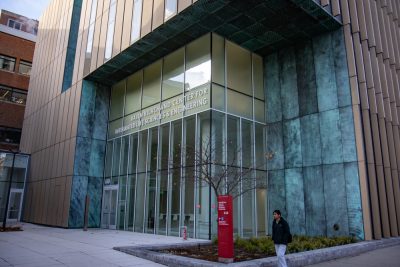With electrodes implanted into its brain, a rat scurries around a pen no more than 20 centimeters in diameter. Seemingly unbothered by the hardware, the rat scours its confined environment in search of its sustenance: crushed Froot Loops.
A group of researchers observe the rat from above. Rather than search for Froot Loops, these scientists watch closely for red dots, an indication of neural activity.
This is a typical scene from Michael Hasselmo’s laboratory at Boston University’s Center for Systems Neuroscience. Hasselmo, a professor in the department of Psychological and Brain Sciences and the director of CSN, established the center in 2014 after a suggestion from then Vice President of research Gloria Waters.

CSN spans the Charles River and Medical Campuses and houses more than 70 laboratories. At these labs, more than 80 BU faculty members conduct research in varying disciplines, from biomedical engineering to speech and hearing sciences to anatomy. Unlike some research centers within the Kilachand Center, CSN has no participation restrictions and is open to all university faculty.
“[New faculty] aren’t just coming into one department,” Hasselmo said. “They’re coming into a community of researchers.”
CSN organizes a myriad of events to foster this sense of community. The Center hosts seminars for guest speakers and symposiums where faculty members showcase their research, typically followed by lunch where the conversation continues. CSN regularly posts about upcoming events and faculty achievements on X, formerly known as Twitter.
Hasselmo’s lab researches the brain’s role in memory function and spatial navigation. One of his current projects conducts trials related to delayed nonmatch position. In this experimental design, mice and rats navigate a T-shaped maze, and the shape of the maze changes with each trial.
The objective of the experiment is to test the animal’s memory of life events, known as episodic memory.
“It seems like a really simple task, but if the animal is doing it 20 or 30 times in a row … that actually puts demands on the episodic memory,” Hasselmo said, “It’s challenging the abilities of the animal to distinguish ‘what did I do 10 seconds ago?’ versus ‘what did I do two minutes ago?’”
Hasselmo’s research has implications for Alzheimer’s disease, since its early symptoms typically occur in memory.
“When you have the symptoms of Alzheimer’s disease, the first things that happen are often that you forget where you left your car keys and where you parked your car,” Hasselmo said. “That is directly related to the damage to the entorhinal cortex and … the hippocampus.”
Hasselmo’s lab also studies the connection between animal and robotic navigation, which has implications for the navigational abilities of autonomous vehicles, like self-driving cars. Recently, CSN received The Office of Naval Research Multidisciplinary University Research Initiative Grant to fund this investigation.
“There’s a lot of interest in understanding how [navigation is] done in the brain in order to make the robotic implementations more robust and more adaptable to changing circumstances,” Hasselmo said.
Mark Kramer, the associate director of CSN and a mathematics and statistics professor, sees CSN as a way to foster collaboration among BU faculty conducting neuroscience projects.
“We didn’t have a central place for all of us to interact,” Kramer said. “[CSN] was, for me, an exciting spot to interact with other colleagues with different perspectives in neuroscience.”
Kramer researches the detection of pathological brain rhythms associated with epilepsy in order to correct them. These corrections are auditory and electrical simulation that aims to improve brain function through the enhancement of memory and reduction of epileptic brain activity.
“We’d like to understand … the [underlying mechanisms] that produce that voltage,” Kramer said. “The way we try to do that is by developing these mathematical models that can tie in the thing we observe, to the things we don’t observe.”
For Michael Economo, an assistant professor of biomedical engineering in the College of Engineering, CSN provides an opportunity to venture outside of his department.
“The center really serves as a hub among that community of people spread across different departments that allows people to interact, to collaborate [and] for people to learn about things that labs outside of the department might be doing,” Economo said.
Hasselmo views the work of CSN as bigger than the field of neuroscience.
“To understand the brain,” Hasselmo said, “is to understand every aspect of human experience.”



























































































































